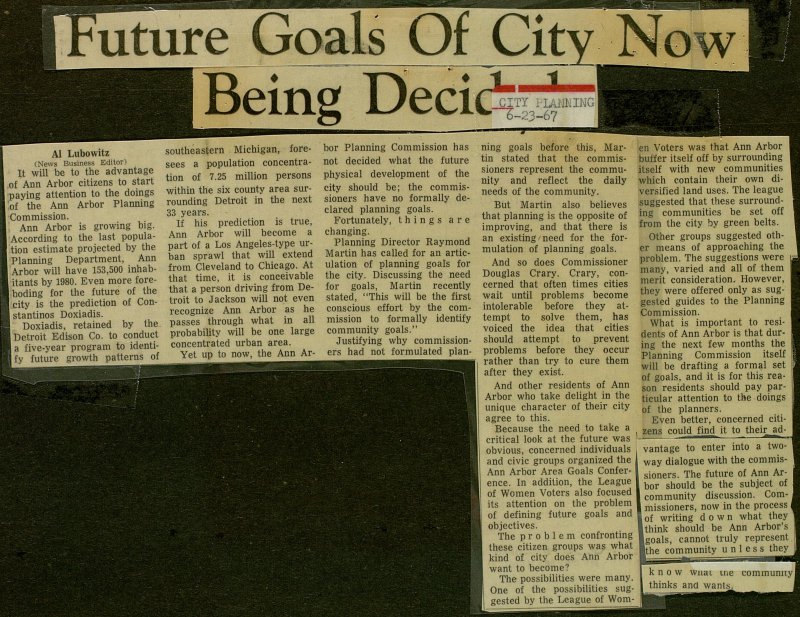Future Goals Of City Now Being Decided

It will be to the advantage of Ann Arbor citizens to start paying attention to the doings of the Ann Arbor Planning Commission. Ann Arbor is growing big. According to the last population estimate projected by the Planning Department, Ann Arbor will have 153,500 inhabitants by 1980. Even more foreboding for the future of the city is the prediction of Constantinos Doxiadis. Doxiadis, retained by the Detroit Edison Co. to conduct a five-year program to identify future growth patterns of southeastern Michigan, foresees a population concentration of 7.25 million persons within the six county area surrounding Detroit in the next 33 years. If his prediction is true, Ann Arbor will become a part of a Los Angeles-type urban sprawl that will extend from Cleveland to Chicago. At that time, it is conceivable that a person driving from Detroit to Jackson will not even recognize Ann Arbor as he passes through what in all probability will be one large concentrated urban area. Yet up to now, the Ann Arbor Planning Commission has not decided what the future physical development of the city should be; the commissioners have no formally declared planning goals. Fortunately, things are changing. Planning Director Raymond Martin has called for an articulation of planning goals for the city. Discussing the need for goals, Martin recently stated, "This will be the first conscious effort by the commission to formally identify community goals." Justifying why commissioners had not formulated planning goals before this, Martin stated that the commissioners represent the community and reflect the daily needs of the community. But Martin also believes that planning is the opposite of improving, and that there is an existing need for the formulation of planning goals. And so does Commissioner Douglas Crary. Crary, concerned that often times cities wait until problems become intolerable before they attempt to solve them, has voiced the idea that cities should attempt to prevent problems before they occur rather than try to cure them after they exist. And other residents of Ann Arbor who take delight in the unique character of their city agree to this. Because the need to take a critical look at the future was obvious, concerned individuals and civic groups organized the Ann Arbor Area Goals Conference. In addition, the League of Women Voters also focused its attention on the problem of defining future goals and objectives. The problem confronting these citizen groups was what kind of city does Ann Arbor want to become? The possibilities were many. One of the possibilities suggested by the League of Women Voters was that Ann Arbor buffer itself off by surrounding itself with new communities which contain their own diversified land uses. The league suggested that these surrounding communities be set off from the city by green belts. Other groups suggested other means of approaching the problem. The suggestions were many, varied and all of them merit consideration. However, they were offered only as suggested guides to the Planning Commission. What is important to residents of Ann Arbor is that during the next few months the Planning Commission itself will be drafting a formal set of goals, and it is for this reason residents should pay particular attention to the doings of the planners. Even better, concerned citizens could find it to their advantage to enter into a two-way dialogue with the commissioners. The future of Ann Arbor should be the subject of community discussion. Commissioners, now in the process of writing down what they think should be Ann Arbor's goals, cannot truly represent the community unless they know what the community thinks and wants.